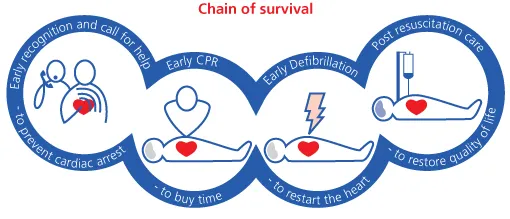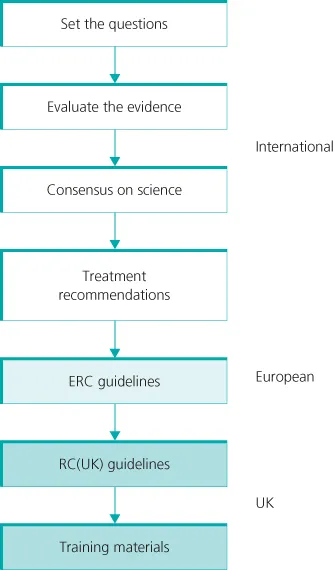
ABC of Resuscitation
- English
- ePUB (mobile friendly)
- Available on iOS & Android
ABC of Resuscitation
About this book
ABC of Resuscitation is a practical, illustrated guide to the latest resuscitation advice for the non-specialist and provides the core knowledge on the treatment of cardiopulmonary arrest.
This edition provides a guide to the European Resuscitation Council Guidelines for Resuscitation 2010 and the Resuscitation Council (UK) 2010 Resuscitation Guidelines.
It Includes:
- the causes and prevention of cardiac arrest
- basic and advanced life support for adults, children and newborns
- resuscitation in a range of contexts (in-hospital and out-of-hospital, including drowning, pregnancy, sport and trauma)
- important aspects of implementation of guidelines including human factors and education
ABC of Resuscitation, 6th Edition is ideal for all healthcare professionals including junior doctors, medical students, general practitioners, paramedics and nurses. It is also useful for pre-hospital care practitioners, emergency medicine trainees, resuscitation officers and all those who teach resuscitation.
This title is also available as a mobile App from MedHand Mobile Libraries. Buy it now from Google Play or the MedHand Store.
Frequently asked questions
- Essential is ideal for learners and professionals who enjoy exploring a wide range of subjects. Access the Essential Library with 800,000+ trusted titles and best-sellers across business, personal growth, and the humanities. Includes unlimited reading time and Standard Read Aloud voice.
- Complete: Perfect for advanced learners and researchers needing full, unrestricted access. Unlock 1.4M+ books across hundreds of subjects, including academic and specialized titles. The Complete Plan also includes advanced features like Premium Read Aloud and Research Assistant.
Please note we cannot support devices running on iOS 13 and Android 7 or earlier. Learn more about using the app.
Information
Cardiac Arrest and the Chain of Survival
- Cardiovascular disease is the commonest cause of cardiac arrest
- Early recognition of warning signs and a call for help can prevent cardiac arrest
- If cardiac arrest occurs, immediate cardiopulmonary resuscitation (CPR) improves chances of survival
- Shockable cardiac arrest rhythms (ventricular fibrillation/pulseless ventricular tachycardia, VF/VT) are treated with attempted defibrillation
- Non-shockable rhythms (asystole and pulseless electrical activity (PEA)) are treated by identifying and treating the underlying cause.
- Post-cardiac arrest care in successfully resuscitated patients determines the final outcome
Epidemiology of cardiac arrest
The chain of survival

Early recognition and call for help
Early CPR
Early defibrillation
Post resuscitation care
- Over 50,000 out-of-hospital cardiac arrests attended by the ambulance service
- About one-third of cardiac arrest victims have bystander CPR before an ambulance crew arrives
- About 30,000 in-hospital cardiac arrests each year
- Survival to discharge for out-of-hospital cardiac arrests is <10%
- Survival to discharge for in-hospital cardiac arrests is 10–20%
Resuscitation guidelines

Further Reading
Sudden Cardiac Death
- SCD can occur at any age, but its frequency increases with increasing age and its causes vary with age
- Ischaemic heart disease is the commonest cause of SCD in people older than 35 years
- Inherited conditions are more common in people below the age of 35
- Warning signs are often absent, but can include chest pain, shortness of breath and syncope
- Identification and treatment of the underlying condition under specialist guidance can prevent SCD
Introduction
Table of contents
- Cover
- Series Page
- Title Page
- Copyright
- List of Contributors
- Foreword
- Chapter 1: Cardiac Arrest and the Chain of Survival
- Chapter 2: Sudden Cardiac Death
- Chapter 3: Causes and Prevention of Cardiac Arrest in Hospital
- Chapter 4: Basic Life Support
- Chapter 5: Advanced Life Support
- Chapter 6: Defibrillation
- Chapter 7: Airway Management and Ventilation
- Chapter 8: Post-Resuscitation Care
- Chapter 9: Paediatric Resuscitation
- Chapter 10: Resuscitation at Birth
- Chapter 11: -of-Hospital Resuscitation
- Chapter 12: In-Hospital CPR
- Chapter 13: Peri-arrest Arrhythmias
- Chapter 14: Pacemakers and Implantable Cardioverter-Defibrillators
- Chapter 15: Cardiorespiratory Arrest in Advanced Pregnancy
- Chapter 16: Drowning
- Chapter 17: Trauma
- Chapter 18: Human Factors
- Chapter 19: CPR Devices
- Chapter 20: Resuscitation in Sport
- Chapter 21: Improving Outcomes from Cardiac Arrest: Quality, Education and Implementation
- Chapter 22: Decisions Relating to Resuscitation
- Index